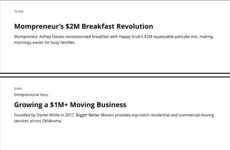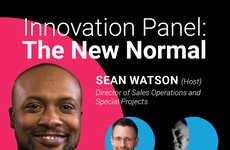
References: inthebooks.800ceoread & inthebooks.800ceoread
In a recent interview for 800-CEO-READ, Jeremy Gutsche shares behind the scenes access to the inner workings of his second published book, 'Better and Faster: The Proven Path to Unstoppable Ideas.' Featured in the Thinker In Residence series, the article explores how Gutsche's first book Exploiting Chaos helped pave the way for the insights and breakthroughs that come together in 'Better and Faster.'
The interview shares Gutsche's methodology behind the the six key patterns of opportunity, the book writing journey as well as his thoughts on how to create balance in the workplace. "I think innovation needs to be balanced," Gutsche says. "You need your more certain, traditional strategies, but you also need a portion of higher risk adapting."
THINKER IN RESIDENCE: A Q&A with Jeremy Gutsche
800-CEO-READ
Because we were such fans of the first book, it’s hard for me to fully separate the two books, so I see Better and Faster as a continuum of the Exploiting Chaos’ ethos. While writing Exploiting Chaos, did you have any sense that you’d come back a half decade later with something more? In some sense, I kind of see B&F as a warning to the people who used your first book to achieve something. In my head I’m hearing you say, “Wonderful! You exploited chaos. Great work, but you can’t become complacent, and here’s how to stay sharp.” Or am I way off base here?
After I wrote Exploiting Chaos, the world tumbled into 6 years of, well, utter chaos. That put me in the right place at the right time and I ended up working for 300 CEOs, brands, and a handful of billionaires who wanted to ensure their companies “Exploited Chaos.” The experience was unbelievable. I went from being a corporate director and author to working on the world’s most difficult problems at the world’s most incredible companies, from Victoria’s Secret and Coca-Cola to IBM and Microsoft. I am very thankful. The experience upped my game and helped lead me to very different book. In short, I created something much more personal from my rare experiences, with a goal that gets to a more important set of problems: how do you actually make change happen when change is hard. Ultimately, there is a very bold lesson that smart people and successful teams get complacent and they miss out. Fortunately, there are several important things you can do about it.
Read the full interview on 800-CEO-READ's Thinker in Residence section HERE and HERE.
The interview shares Gutsche's methodology behind the the six key patterns of opportunity, the book writing journey as well as his thoughts on how to create balance in the workplace. "I think innovation needs to be balanced," Gutsche says. "You need your more certain, traditional strategies, but you also need a portion of higher risk adapting."
THINKER IN RESIDENCE: A Q&A with Jeremy Gutsche
800-CEO-READ
Because we were such fans of the first book, it’s hard for me to fully separate the two books, so I see Better and Faster as a continuum of the Exploiting Chaos’ ethos. While writing Exploiting Chaos, did you have any sense that you’d come back a half decade later with something more? In some sense, I kind of see B&F as a warning to the people who used your first book to achieve something. In my head I’m hearing you say, “Wonderful! You exploited chaos. Great work, but you can’t become complacent, and here’s how to stay sharp.” Or am I way off base here?
After I wrote Exploiting Chaos, the world tumbled into 6 years of, well, utter chaos. That put me in the right place at the right time and I ended up working for 300 CEOs, brands, and a handful of billionaires who wanted to ensure their companies “Exploited Chaos.” The experience was unbelievable. I went from being a corporate director and author to working on the world’s most difficult problems at the world’s most incredible companies, from Victoria’s Secret and Coca-Cola to IBM and Microsoft. I am very thankful. The experience upped my game and helped lead me to very different book. In short, I created something much more personal from my rare experiences, with a goal that gets to a more important set of problems: how do you actually make change happen when change is hard. Ultimately, there is a very bold lesson that smart people and successful teams get complacent and they miss out. Fortunately, there are several important things you can do about it.
Read the full interview on 800-CEO-READ's Thinker in Residence section HERE and HERE.
Trend Themes
1. Six Key Patterns of Opportunity - Identify and capitalize on the key patterns of opportunity for innovative ideas and breakthroughs.
2. Balancing Innovation - Find the right balance between traditional strategies and higher risk adapting to foster innovation in the workplace.
3. Making Change Happen - Learn how to make change happen even when it's difficult, addressing important problems and avoiding complacency.
Industry Implications
1. Publishing - Explore disruptive innovations in the publishing industry to transform the way books are written, published, and distributed.
2. Consulting - Uncover opportunities for disruptive innovations in the consulting industry to help businesses navigate through chaotic times and drive growth.
3. Technology - Harness the power of technology to facilitate change and drive innovation in various industries, from retail to healthcare.
2.2
Score
Popularity
Activity
Freshness























